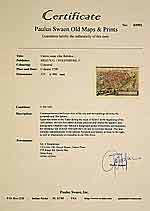Lot #: 84969
Hagae Comitis celeberrimi totius Evropae municipij typus [The Hague/Den Haag.] |
||||||||||||||||||||
|
||||||||||||||||||||
|
|
||||||||||||||||||||
|
Selling price: $720
Sold in 2021 Join our News Letter to get informed when a similar item comes available. Do you have an example you would like to sell? |
Views: 329
|
|||||||||||||||||||
Description
A birds-eye-view / town plan of The Hague. - This view comes from the sixth and last volume of the 'Civitates Orbis Terrarum' ("Theatri Praecipuarum Totius Mundi Urbivm Liber Sextus"), published in a much smaller edition than previous volumes, and it is, therefore, rarer than most of Braun & Hogenberg city views, published by A. Hierat in Cologne, 1618. With an ornamental title-cartouche, and another ornamental cartouche with explanatory notes (1.-18) and 2 coats-of-arms.
CARTOUCHE: Impression of the Hague, a city famous in all Europe. COMMENTARY BY BRAUN: "The residence of the counts, called the court, is very well known, and is surrounded by poor walls and ditches. It is said to have been built by Count William, who was also the Roman king. As far as the village itself is concerned, it is as big as a medium-sized town, and, like other towns, has paved streets with houses standing very close together."
The bird's-eye view plan from the southwest shows an impressive unfortified residential city, traversed by canals, with densely packed and often very uniform townhouses. Standing out clearly in the plan is the curious late Gothic Sint-Jacobskerk (4). On the right immediately next to it is the Renaissance town hall (3) and below the court pond is the palace (1) with its big, rectangular inner courtyard and the Knights' Hall (Ridderzaal).
Originally, there was a hunting lodge here, which was extended to a seat of government by Counts William II and Floris V of Holland in the 13th century. Today the city has a population of around 475,000 and is the royal residence and seat of the Dutch government and Parliament, as well as a number of international institutions such as the International Court of Justice.
Braun G. & Hogenberg F. and the Civitates Orbis Terrarum. The 'Civitates Orbis Terrarum', or the "Braun & Hogenberg", is a six-volume town atlas and the greatest book of town views and plans ever published: 363 engravings, sometimes beautifully colored. It was one of the best-selling works in the last quarter of the 16th century. Georg Braun wrote the text accompanying the plans and views on the verso.
A large number of the plates were engraved after the original drawings of Joris Hoefnagel (1542-1600), who was a professional artist. The first volume was published in Latin in 1572, the sixth volume in 1617. Frans Hogenberg created the tables for volumes I through IV, and Simon van den Neuwel created those for volumes V and VI.
Other contributors were cartographer Daniel Freese, and Heinrich Rantzau. Works by Jacob van Deventer, Sebastian Münster, and Johannes Stumpf were also used. Translations appeared in German and French.
Following the original publication of Volume 1 of the 'Civitates' in 1572, seven further editions of 1575, 1577, 1582, 1588, 1593, 1599 and 1612 can be identified. Vol.2, first issued in 1575, was followed by further editions in 1597 and in 1612. The next volumes appeared in 1581, 1588, 1593, 1599 and 1606. The German translation of the first volume appeared from 1574 on and the French edition from 1575 on.
Several printers were involved: Theodor Graminaeus, Heinrich von Aich, Gottfried von Kempen, Johannis Sinniger, Bertram Buchholtz and Peter von Brachel, who all worked in Cologne.
Georg Braun (1541-1622) was born in Cologne in 1541. After his studies in Cologne, he entered the Jesuit Order as a novice. In 1561 he obtained his bachelor's degree and in 1562 his Magister Artium. Although he left the Jesuit Order, he studied theology, gaining a licentiate in theology.
Frans Hogenberg (1535-1590) was a Flemish and German painter, engraver, and mapmaker. He was born in Mechelen as the son of Nicolaas Hogenberg.
By the end of the 1560s Frans Hogenberg was employed upon Abraham Ortelius's Theatrum Orbis Terrarum, published in 1570; he is named as engraver of numerous maps. In 1568 he was banned from Antwerp by the Duke of Alva and traveled to London, where he stayed a few years before emigrating to Cologne. There he immediately embarked on his two most important works, the 'Civitates' published from 1572 and the 'Geschichtsblätter', which appeared in several series from 1569 until about 1587.
Thanks to such large-scale projects as the Geschichtsblätter and the Civitates, Hogenberg's social circumstances improved with each passing year. He died as a wealthy man in Cologne in 1590.
Reference: Koeman IV, map 1033, ed. 41:1 (1617/18 B&H 6).(Van der Krogt, 41:2.6)
CARTOUCHE: Impression of the Hague, a city famous in all Europe. COMMENTARY BY BRAUN: "The residence of the counts, called the court, is very well known, and is surrounded by poor walls and ditches. It is said to have been built by Count William, who was also the Roman king. As far as the village itself is concerned, it is as big as a medium-sized town, and, like other towns, has paved streets with houses standing very close together."
The bird's-eye view plan from the southwest shows an impressive unfortified residential city, traversed by canals, with densely packed and often very uniform townhouses. Standing out clearly in the plan is the curious late Gothic Sint-Jacobskerk (4). On the right immediately next to it is the Renaissance town hall (3) and below the court pond is the palace (1) with its big, rectangular inner courtyard and the Knights' Hall (Ridderzaal).
Originally, there was a hunting lodge here, which was extended to a seat of government by Counts William II and Floris V of Holland in the 13th century. Today the city has a population of around 475,000 and is the royal residence and seat of the Dutch government and Parliament, as well as a number of international institutions such as the International Court of Justice.
Braun G. & Hogenberg F. and the Civitates Orbis Terrarum. The 'Civitates Orbis Terrarum', or the "Braun & Hogenberg", is a six-volume town atlas and the greatest book of town views and plans ever published: 363 engravings, sometimes beautifully colored. It was one of the best-selling works in the last quarter of the 16th century. Georg Braun wrote the text accompanying the plans and views on the verso.
A large number of the plates were engraved after the original drawings of Joris Hoefnagel (1542-1600), who was a professional artist. The first volume was published in Latin in 1572, the sixth volume in 1617. Frans Hogenberg created the tables for volumes I through IV, and Simon van den Neuwel created those for volumes V and VI.
Other contributors were cartographer Daniel Freese, and Heinrich Rantzau. Works by Jacob van Deventer, Sebastian Münster, and Johannes Stumpf were also used. Translations appeared in German and French.
Following the original publication of Volume 1 of the 'Civitates' in 1572, seven further editions of 1575, 1577, 1582, 1588, 1593, 1599 and 1612 can be identified. Vol.2, first issued in 1575, was followed by further editions in 1597 and in 1612. The next volumes appeared in 1581, 1588, 1593, 1599 and 1606. The German translation of the first volume appeared from 1574 on and the French edition from 1575 on.
Several printers were involved: Theodor Graminaeus, Heinrich von Aich, Gottfried von Kempen, Johannis Sinniger, Bertram Buchholtz and Peter von Brachel, who all worked in Cologne.
Georg Braun (1541-1622) was born in Cologne in 1541. After his studies in Cologne, he entered the Jesuit Order as a novice. In 1561 he obtained his bachelor's degree and in 1562 his Magister Artium. Although he left the Jesuit Order, he studied theology, gaining a licentiate in theology.
Frans Hogenberg (1535-1590) was a Flemish and German painter, engraver, and mapmaker. He was born in Mechelen as the son of Nicolaas Hogenberg.
By the end of the 1560s Frans Hogenberg was employed upon Abraham Ortelius's Theatrum Orbis Terrarum, published in 1570; he is named as engraver of numerous maps. In 1568 he was banned from Antwerp by the Duke of Alva and traveled to London, where he stayed a few years before emigrating to Cologne. There he immediately embarked on his two most important works, the 'Civitates' published from 1572 and the 'Geschichtsblätter', which appeared in several series from 1569 until about 1587.
Thanks to such large-scale projects as the Geschichtsblätter and the Civitates, Hogenberg's social circumstances improved with each passing year. He died as a wealthy man in Cologne in 1590.
Reference: Koeman IV, map 1033, ed. 41:1 (1617/18 B&H 6).(Van der Krogt, 41:2.6)
FAQ - Guarantee - Shipping
In our BUY-or-BID sale, you never pay more than the Buy price.
To buy or bid in this Buy-or-Bid sale you must register with us. It is free, and we automatically update you about future auctions.During the Buy-or-Bid sale, you can buy or bid on 600- 900 antique, rare maps, town views, old master prints, decorative prints, atlases, posters and Medieval manuscripts.
- We show the "Bid & Ask spread" (to define the gap between the minimum accepted bid and Buy price.)
- Items that have received bids within the BidAsk spread are sold at the highest bid at closing.
- Once the Buy price is paid, the sale for this item has closed.
Do you have a similar item you want to sell ?
Interested in selling your antique maps, original prints, vintage posters, or historic Ephemera?Let us help you!
Start your consignment today. We provide estimates free of charge from photographs sent via the Internet. Fill out our online estimation form, and we will contact you with an estimate.
Learn more about consigning at RarePaperSales.com
Guarantee
 We warranty the authenticity of each lot offered in our sale. There is no time limitation to this guarantee.
We warranty the authenticity of each lot offered in our sale. There is no time limitation to this guarantee.- Defects in lots have been carefully noted.
- If there are no remarks regarding splits, tears, discoloration, etc., there are no issues to be found for the item!
- All items are carefully and personally examined before being packed "in-house" and shipped by UPS, USPS, DHL or registered mail.
- We do not sell reproductions.
- A certificate of authenticity is provided for each acquired item and can be downloaded from your invoice page.
- Certificates can be found in the Invoice and Certificates center.
Shipping
Maps are shipped in solid tubes or flat between solid cardboard. Fully insured, signature required, and with online tracking. Shortly after shipment, you will get the tracking number by email.The standard is that we ship items by UPS or DHL for European destinations, and a flat shipping fee is added to each shipment. It is a one-time fee even if you buy multiple items. This fee covers shipping and insurance (up to the invoice amount) to:
- North America, Canada, Europe $ 30
- Asia $ 40
- For South America, Mauritius, Africa and Australia a shipping fee of $ 50 will be charged.
We charge only a one-time shipping fee if you have won 2 or more items.

Hold Shipment Service
Rare Paper Sales allows you to put your shipping on hold at no additional charge. This can be incredibly convenient for people who want to buy several items at different auctions and ship them together. The service is free, and you pay only one shipment fee.
Contact us if you want to use the Hold Service.
High-Resolution Digital Image Download |
|
|
RarePaperSales maintains an archive of most of our high-resolution rare maps, prints, posters and medieval manuscript scans. We make them freely available for download and study. Read more about free image download |
![Old map image download for Hagae Comitis celeberrimi totius Evropae municipij typus [The Hague/Den Haag.]](/uploads/cache/84969-500x500.jpg)